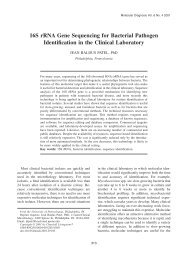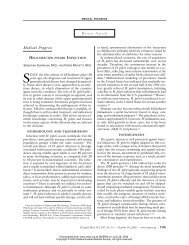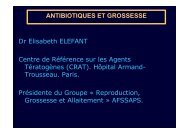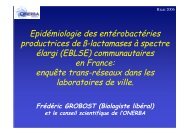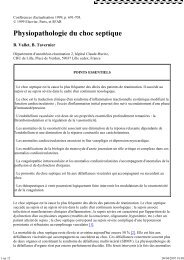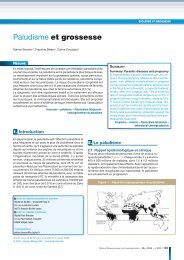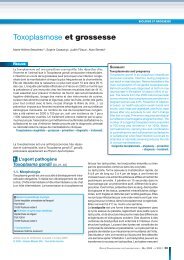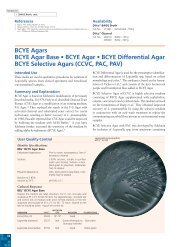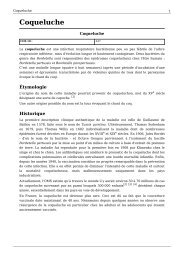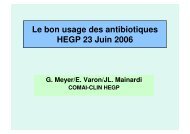Principles and Practice of Clinical Bacteriology Second Edition - Free
Principles and Practice of Clinical Bacteriology Second Edition - Free
Principles and Practice of Clinical Bacteriology Second Edition - Free
You also want an ePaper? Increase the reach of your titles
YUMPU automatically turns print PDFs into web optimized ePapers that Google loves.
16 β-HAEMOLYTIC STREPTOCOCCI<br />
(Kotl<strong>of</strong>f et al. 2004), which has provided the first evidence that a<br />
hybrid fusion protein is a feasible strategy for evoking type-specific<br />
opsonic antibodies against multiple serotypes <strong>of</strong> GAS without eliciting<br />
antibodies that cross-react with host tissues. This represents a critical<br />
step in GAS vaccine development.<br />
The conserved C-terminus <strong>of</strong> the M protein has also been considered<br />
as a vaccine c<strong>and</strong>idate. Conserved T-cell epitopes, which are thought<br />
to be rheumatogenic, reside in the C-terminus <strong>of</strong> the protein<br />
(Robinson, Case <strong>and</strong> Kehoe 1993; Pruksakorn et al. 1994), though<br />
rheumatogenic T-cell epitopes may also exist in the variable N-terminus<br />
(Guilherme et al. 2000). These considerations have greatly complicated<br />
GAS vaccine development because <strong>of</strong> fears <strong>of</strong> precipitating RF in<br />
vaccinated individuals (Pruksakorn et al. 1994; Br<strong>and</strong>t et al. 2000).<br />
Recent studies suggest that opsonic antibodies to M protein alone<br />
are insufficient for opsonophagocytosis <strong>of</strong> S. pyogenes, emphasising<br />
the need to seek additional vaccine c<strong>and</strong>idates. Certain non-M-protein<br />
antigens have already been evaluated in preclinical models, including<br />
the streptococcal C5a peptidase, the streptococcal cysteine protease<br />
(SPEB) <strong>and</strong> the GAS carbohydrate.<br />
Although maternal intrapartum antibiotic prophylaxis is clearly<br />
effective <strong>and</strong> has reduced the incidence <strong>of</strong> early-onset GBS neonatal<br />
disease substantially in the United States, it cannot prevent late-onset<br />
GBS disease. Vaccination <strong>of</strong> women <strong>of</strong> childbearing age against GBS<br />
could theoretically prevent both early-onset <strong>and</strong> late-onset GBS<br />
disease in the neonate, in addition to preventing GBS disease in<br />
pregnant women. Opsonic antibodies directed against the capsular<br />
polysaccharide <strong>of</strong> GBS confer serotype-specific protection. Initial<br />
vaccines developed focused on capsular type III isolates, but the<br />
emergence <strong>of</strong> type V isolates in recent years has prompted the<br />
development <strong>of</strong> a polyvalent GBS vaccine (Baker <strong>and</strong> Edwards<br />
2003). Vaccines have been developed by coupling purified capsular<br />
polysaccharide antigen <strong>of</strong> GBS with an immunogenic protein carrier.<br />
Glycoconjugate vaccines against all nine currently identified GBS<br />
serotypes have been synthesised <strong>and</strong> shown to be immunogenic in<br />
animal models <strong>and</strong> in human phase I <strong>and</strong> II trials. The recent results<br />
strongly suggest that GBS conjugate vaccines may be effective in the<br />
prevention <strong>of</strong> GBS disease (Paoletti <strong>and</strong> Kasper 2003).<br />
REFERENCES<br />
American Heart Association (1992) Guidelines for the diagnosis <strong>of</strong> rheumatic<br />
fever. Jones Criteria, 1992 update. Special Writing Group <strong>of</strong> the<br />
Committee on Rheumatic Fever, Endocarditis, <strong>and</strong> Kawasaki Disease <strong>of</strong><br />
the Council on Cardiovascular Disease in the Young <strong>of</strong> the American Heart<br />
Association. <strong>Clinical</strong> Infectious Diseases, 268, 2069–2073.<br />
Ayoub EM, Kotb M, Cunningham MW (2000) Rheumatic fever pathogenesis.<br />
In Streptococcal Infections: <strong>Clinical</strong> Aspects, Microbiology <strong>and</strong> Molecular<br />
Pathogenesis. Stevens DL, Kaplan EL (eds). Oxford University Press,<br />
pp. 102–132.<br />
Baker CJ, Edwards MS (2003) Group B streptococcal conjugate vaccines.<br />
Archives <strong>of</strong> Disease in Childhood, 88, 375–378.<br />
Basma H, Norrby-Teglund A, McGeer A et al. (1998) Opsonic antibodies<br />
to the surface M protein <strong>of</strong> group A streptococci in pooled normal<br />
immunoglobulins (IVIG): potential impact on the clinical efficacy <strong>of</strong> IVIG<br />
therapy for severe invasive group A streptococcal infections. Infection <strong>and</strong><br />
Immunity, 66, 2279–2283.<br />
Beall B, Facklam R, Thompson T (1996) Sequencing emm-specific PCR<br />
products for routine <strong>and</strong> accurate typing <strong>of</strong> group A streptococci. Journal<br />
<strong>of</strong> <strong>Clinical</strong> Microbiology, 34, 953–958.<br />
Belcher DW, Afoakwa SN, Osei-Tutu E et al. (1977) Endemic pyoderma in<br />
Ghana: a survey in rural villages. Transactions <strong>of</strong> the Royal Society <strong>of</strong><br />
Tropical Medicine <strong>and</strong> Hygiene, 71, 204–209.<br />
Ben-Abraham R, Keller N, Vered R et al. (2002) Invasive group A streptococcal<br />
infections in a large tertiary center: epidemiology, characteristics <strong>and</strong><br />
outcome. Infection, 30, 81–85.<br />
Beres SB, Sylva GL, Barbian KD et al. (2002) Genome sequence <strong>of</strong> a serotype<br />
M3 strain <strong>of</strong> group A streptococcus: phage-encoded toxins, the highvirulence<br />
phenotype, <strong>and</strong> clone emergence. Proceedings <strong>of</strong> the National<br />
Academy <strong>of</strong> Sciences <strong>of</strong> the United States <strong>of</strong> America, 99, 10078–10083.<br />
Bergeron MG, Ke D, Menard C et al. (2000) Rapid detection <strong>of</strong> group B<br />
streptococci in pregnant women at delivery. The New Engl<strong>and</strong> Journal <strong>of</strong><br />
Medicine, 343, 175–179.<br />
Bessen DE, Carapetis JR, Beall B et al. (2000) Contrasting molecular epidemiology<br />
<strong>of</strong> group A streptococci causing tropical <strong>and</strong> nontropical infections<br />
<strong>of</strong> the skin <strong>and</strong> throat. The Journal <strong>of</strong> Infectious Diseases, 182, 1109–1116.<br />
Bisno AL (1991) Group A streptococcal infections <strong>and</strong> acute rheumatic fever.<br />
The New Engl<strong>and</strong> Journal <strong>of</strong> Medicine, 325, 783–793.<br />
Bisno AL, Brito MO, Collins CM (2003) Molecular basis <strong>of</strong> group A streptococcal<br />
virulence. The Lancet Infectious Diseases, 3, 191–200.<br />
Bisno AL, Gerber MA, Gwaltney JM Jr et al. (2002) <strong>Practice</strong> guidelines for the<br />
diagnosis <strong>and</strong> management <strong>of</strong> group A streptococcal pharyngitis. Infectious<br />
Diseases Society <strong>of</strong> America. <strong>Clinical</strong> Infectious Diseases, 35, 113–125.<br />
Br<strong>and</strong>t ER, Sriprakash KS, Hobb RI et al. (2000) New multi-determinant<br />
strategy for a group A streptococcal vaccine designed for the Australian<br />
Aboriginal population. Nature Medicine, 6, 455–459.<br />
Brook I, Gober AE, Leyva F (1995) In vitro <strong>and</strong> in vivo effects <strong>of</strong> penicillin <strong>and</strong><br />
clindamycin on expression <strong>of</strong> group A beta-hemolytic streptococcal<br />
capsule. Antimicrobial Agents <strong>and</strong> Chemotherapy, 39, 1565–1568.<br />
Centers for Disease Control <strong>and</strong> Prevention (1999) Active Bacterial Core<br />
Surveillance (ABCs) Report. Emerging Infections Program Network:<br />
group B Streptococcus, 1997. www.cdc.gov/ncidod/dbmd/abcs/survreports/<br />
gbs97.pdf (25 August 2004).<br />
Centers for Disease Control <strong>and</strong> Prevention (2003) Active Bacterial Core<br />
Surveillance (ABCs) Report. Emerging Infections Program Network:<br />
Group B Streptococcus, 2002. www.cdc.gov/ncidod/dbmd/abcs/survreports/<br />
gbs02.pdf (25 August 2004).<br />
Centers for Disease Control <strong>and</strong> Prevention (2004a) Active Bacterial Core<br />
Surveillance Report, Emerging Infections Program Network, Group A<br />
Streptococcus, 2003. CDC, Atlanta, GA.<br />
Centers for Disease Control <strong>and</strong> Prevention (2004b) Active Bacterial Core<br />
Surveillance Report, Emerging Infections Program Network, Group B<br />
Streptococcus, 2003. CDC, Atlanta, GA.<br />
Chaffin DO, Beres SB, Yim HH, Rubens CE (2000) The serotype <strong>of</strong> type<br />
Ia <strong>and</strong> III group B streptococci is determined by the polymerase gene<br />
within the polycistronic capsule operon. Journal <strong>of</strong> <strong>Bacteriology</strong>, 182,<br />
4466–4477.<br />
Chaussee MS, Somerville GA, Reitzer L, Musser JM (2003) Rgg coordinates<br />
virulence factor synthesis <strong>and</strong> metabolism in Streptococcus pyogenes.<br />
Journal <strong>of</strong> <strong>Bacteriology</strong>, 185, 6016–6024.<br />
Chopra L, Roberts M (2001) Tetracycline antibiotics: mode <strong>of</strong> action,<br />
applications, molecular biology, <strong>and</strong> epidemiology <strong>of</strong> bacterial resistance.<br />
Microbiology <strong>and</strong> Molecular Biology Reviews, 65, 232–260.<br />
Cleary PP, Kaplan EL, H<strong>and</strong>ley JP et al. (1992) Clonal basis for resurgence<br />
<strong>of</strong> serious Streptococcus pyogenes disease in the 1980s. Lancet, 339,<br />
518–521.<br />
C<strong>of</strong>fey TJ, Enright MC, Daniels M et al. (1998) Recombinational exchanges at<br />
the capsular polysaccharide biosynthetic locus lead to frequent serotype<br />
changes among natural isolates <strong>of</strong> Streptococcus pneumoniae. Molecular<br />
Microbiology, 27, 73–83.<br />
Cohen ML (2000) Changing patterns <strong>of</strong> infectious disease. Nature, 406,<br />
762–767.<br />
Cohen-Poradosu R, Jaffe J, Lavi D et al. (2004) Group G streptococcal<br />
bacteremia in Jerusalem. Emerging Infectious Diseases, 10, 1455–1460.<br />
Collin M, Olsén A (2003) Extracellular enzymes with immunomodulating<br />
activities: variations on a theme in Streptococcus pyogenes. Infection <strong>and</strong><br />
Immunity, 71, 2983–2992.<br />
Colman G (1988) Typing <strong>of</strong> Streptococcus agalactiae (Lancefield group B).<br />
European Journal <strong>of</strong> <strong>Clinical</strong> Microbiology & Infectious Diseases, 7,<br />
226–231.<br />
Colman G, Tanna A, Efstratiou A, Gaworzewska ET (1993) The serotypes<br />
<strong>of</strong> Streptococcus pyogenes present in Britain during 1980–1990 <strong>and</strong><br />
their association with disease. Journal <strong>of</strong> Medical Microbiology, 39,<br />
165–178.<br />
Cone LA, Woodard DR, Schlievert PM, Tomory GS (1987) <strong>Clinical</strong> <strong>and</strong><br />
bacteriologic observations <strong>of</strong> a toxic shock-like syndrome due to Streptococcus<br />
pyogenes. The New Engl<strong>and</strong> Journal <strong>of</strong> Medicine, 317, 146–149.<br />
Cornaglia G, Ligozzi M, Mazzariol A et al. (1998) Resistance <strong>of</strong> Streptococcus<br />
pyogenes to erythromycin <strong>and</strong> related antibiotics in Italy. The Italian<br />
Surveillance Group for Antimicrobial Resistance. <strong>Clinical</strong> Infectious<br />
Diseases, 27(Suppl. 1), S87–S92.<br />
Courtney HS, Hasty DL, Dale JB (2002) Molecular mechanisms <strong>of</strong> adhesion,<br />
colonization, <strong>and</strong> invasion <strong>of</strong> group A streptococci. Annals <strong>of</strong> Medicine,<br />
34, 77–87.




